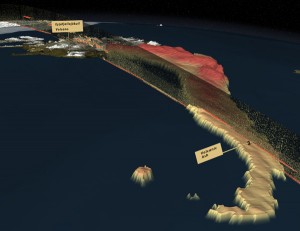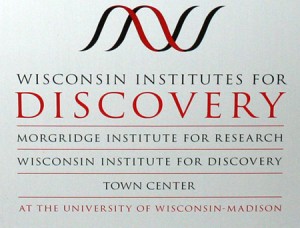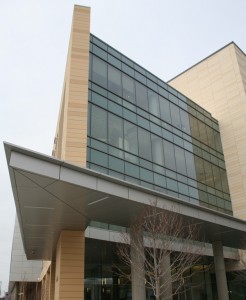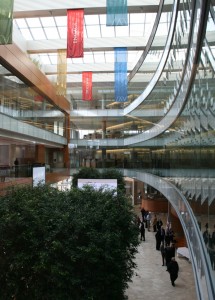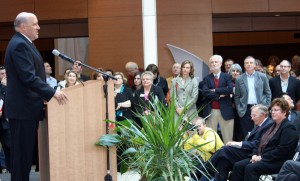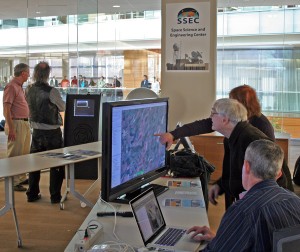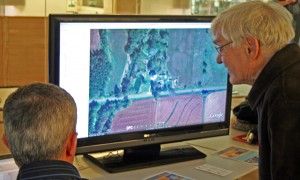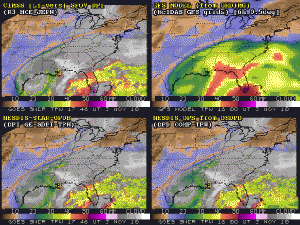Monthly Summary News – December 2010
- SSEC Scientist Chosen to Support Venus Climate Orbiter Team
- Dramatic Images of Volcanic Ash Cloud Created with Techniques Developed at SSEC
- SSEC Participates in Wisconsin Institutes for Discovery Grand Opening
- SSEC and AOS Team Up for Madison Children’s Museum Weather Event
- Mooney Serves on White House Roundtable
- Release of Latest Version of GOES Sounder Retrieval Software from CIMSS
- Meeting with Iceland’s President
- Visit to the Australian Bureau of Meteorology Headquarters
- Kaba Bah’s Poster Named Best Graduate Student Presentation
SSEC Scientist Chosen to Support Venus Climate Orbiter Team
NASA has established a Venus Climate Orbiter Participating Scientist Program to complement scientific return of the Japan Aerospace Exploration Agency (JAXA)-led Venus Climate Orbiter, or “Akatsuki” mission. The Participating Scientist Program will fund two scientists in residence to live in Japan and five Participating Scientists to conduct joint research with the Venus Climate Orbiter science team.
Named as a Participating Scientist in Residence is Sanjay Limaye (SSEC), whose proposal is entitled: “Investigation of Venus Weather as a Participating Scientist in Residence.” Rose Pertzborn (SSEC) will act as a Co-Investigator in the program.
This global view of the surface of Venus is centered at 180 degrees east longitude.
Image credit: NASA/JPL
The Akatsuke mission is due to arrive in Venus orbit on 07 December 2010 and will follow the westward rotation of the planet’s atmosphere, mapping the circulation, evolution, and vertical structure of Venus’ thick clouds.
Dramatic Images of Volcanic Ash Cloud Created with Techniques Developed at SSEC
During April and May 2010, the Eyjafjallajökull volcano on Iceland’s southern coast erupted, creating an expansive ash cloud that disrupted air traffic throughout Europe and across the Atlantic. An article and several animations show the flow of this ash cloud for three days in early May on an hourly basis as sensed from a geostationary satellite.
The ash cloud heights were determined using new methods of retrieving ash cloud properties from infrared radiances developed by Mike Pavolonis (NOAA/NESDIS/STAR) and Justin Sieglaff (UW-CIMSS) for the next generation of Geostationary Operational Environmental Satellite (GOES-R).
SSEC Participates in Wisconsin Institutes for Discovery Grand Opening
The Grand Opening ceremony for the impressive new Wisconsin Institutes for Discovery (WID) building began at 1 pm on 02 December 2010 with Governor Jim Doyle, Chancellor Biddy Martin, and a room full of luminaries honoring the occasion. Special exhibits and demonstrations will continue through the weekend and next week.
Exterior of the Wisconsin Institutes for Discovery.
WID atrium.
Governor Jim Doyle addresses a full house, with Chancellor Biddy Martin in a front row seat.
SSEC was invited to participate in the extensive array of scientific displays and demonstrations. The 3D globe will be available for viewing from 03 – 11 December. SSEC is also displaying its Weather and Climate Applets, MODIS Today and Google Earth, and OWL, the Online Weather Looper.
Rick Kohrs, Tom Whittaker (rear) and Liam Gunley (foreground) demonstrate satellite imagery.
Liam Gumley calls up a satellite view of an attendee’s farm.
Setup of the many SSEC displays was handled by Bill Bellon, Liam Gumley, Rick Kohrs, Margaret Mooney, Will Robus, Maria Vasys, and Tom Whittaker.
The WID will house the public Wisconsin Institute for Discovery and the private Morgridge Institute for Research in a single, four-story facility which will serve as a hub for interdisciplinary research. The 106,000 assignable square feet of research space, including wet and dry laboratories, research support areas, core facilities and offices will provide a gateway to campus for the public.The building also will be home to teaching labs, designed as “dream” collaborative learning environments.
The main floor of the facility is being built as a Town Center to welcome all with food, interactive displays, ongoing activities, hands-on learning labs, events and meeting spaces. It will include public gathering spaces, shops and restaurants designed to revitalize the streets around the facility and enrich the campus environment.
University Communications has published in-depth article concerning the scientific focus of the WID.
SSEC and AOS Team Up for Madison Children’s Museum Weather Event
SSEC’s Claire Petterson and Margaret Mooney were joined by AOS graduate students Sharon Jaffe and Ross Dixon at the Madison Children’s Museum premier rooftop weather event Thursday, 04 November 2010.
The team helped budding weather weenies make observations of clouds, precipitation, temperature, wind speed (via a Kestrel hand-held meter) and wind direction (via soap bubbles!). Approximately 30 future scientists were awarded cool weather badges in the form of AOS lapel pins featuring Bucky Badger holding a lightning bolt. Fun science was had by all.
Mooney Serves on White House Roundtable
At the invitation of the Interagency Climate Change Adaptation Task Force, Margaret Mooney participated in a Roundtable on Communicating Climate Change Adaptation in Washington DC on 02-03 November 2010. Mooney joined experts from around the nation to help the U.S. Government build greater awareness about the importance of climate change adaptation and improve messaging for delivery of the Task Force’s findings and recommendations.
The Task Force, co-chaired by the White House Council on Environmental Quality (CEQ), the Office of Science and Technology Policy (OSTP), and the National Oceanic and Atmospheric Administration (NOAA), released a report in October recommending actions to expand and strengthen the Nation’s capacity to prepare and respond to climate change. The Roundtable developed key recommendations and strategies to communicate findings from the report.
Release of Latest Version of GOES Sounder Retrieval Software from CIMSS
CIMSS provided the latest version of the Geostationary Operational Environmental Satellite (GOES) temperature and moisture retrieval software from the Cooperative Institute for Meteorological Satellite Studies (CIMSS) to NESDIS scientists.
In addition to updates to allow the software to compile properly using a more current Fortran compiler, updates were made to the cloud-clearing portion of the code, which should bring that aspect of the processing more in line with the latest GOES cloud-processing software used at CIMSS, as well as the software that generates the guess temperature and moisture profiles. Work will now proceed between CIMSS and NESDIS to incorporate pertinent portions of this code into the NESDIS software environment.
Sample of a scripted web tool showing near real-time monitoring of Total Precipitable Water (TPW) derived from the (current East) GOES-13 Sounder for the nominal time period of 1800 UTC on 03 November 2010 over the central and eastern US. The panels simultaneously show: upper left – the current GOES Sounder development (“Li”) retrievals, from CIMSS-ASPB; upper right – current first guess (from a NWS forecast model); lower left – current GOES Sounder legacy (“Ma”) retrievals, from NESDIS/StAR/SMCD/OPDB; and lower right – current GOES Sounder operational (legacy, “Ma”) retrievals, from NESDIS/OSDPD/SSD.
Meeting with Iceland’s President
Jeff Key (NESDIS/STAR) and Barry Goodison (World Meteorological Organization, WMO) had a one-hour meeting with the President of Iceland, Ólafur Ragnar Grímsson, at his residence outside of Reykjavik, Iceland, on 17 November 2010. Also present at the meeting were Árni Snorrason, Director of the Icelandic Meteorological Office (IMO), and the president’s Chief of Staff.
President Grímsson is interested in Iceland’s contributions to international efforts involving the Arctic, so Key and Goodison were asked to brief him on the development of the WMO Global Cryosphere Watch initiative and the Arctic Council’s Snow, Water, Ice, and Permafrost in the Arctic (SWIPA) project. The open discussion (over tea and cake) produced a number of useful comments and suggestions.
Given Iceland’s location at the southern extent of the Arctic, and the unique conditions that result from the island’s geothermal activity, data on its glaciers, ice caps, snow cover, and solid precipitation will be an important contribution to the Global Cryosphere Watch.
Visit to the Australian Bureau of Meteorology Headquarters
Mike Pavolonis (NOAA/NESDIS/STAR) visited the Centre for Australian Weather and Climate Research (CAWCR) at the Australian Bureau of Meteorology (BoM) Headquarters in Melbourne during the week of 14 November 2010. During the visit, Pavolonis gave seminars on the NOAA/NESDIS/STAR volcanic ash and cloud products.
In addition, the GEOstationary Cloud Algorithm Testbed (GEOCAT) was installed and tested on BoM operational hardware. GEOCAT is being used by the BoM to generate the NOAA/NESDIS/STAR volcanic ash products in near real-time from MODerate Resolution Imaging Spectroradiometer (MODIS) direct broadcast data received in Darwin Australia.
The volcanic ash products will be made available to operational forecasters at the Darwin Volcanic Ash Advisory Center (VAAC). The GEOCAT installation at BoM will also eventually be used to generate NOAA/NESDIS/STAR developed cloud products and volcanic ash products for the Multi-Functional Transport Satellite (MTSAT) geostationary series.
Kaba Bah’s Poster Named Best Graduate Student Presentation
A poster presentation titled “Working with the National Weather Service (NWS) Forecasters in Preparation for use of the GOES-R Advanced Baseline Imager (ABI),” by Kaba Bah of the Cooperative Institute for Meteorological Satellite Studies (CIMSS), was recently announced as the best graduate student poster presentation at the National Weather Association (NWA) Annual Meeting in Tucson, Arizona, which took place 02-07 October 2010. His poster had numerous coauthors from CIMSS and the NESDIS/STAR Advanced Satellite Products Branch (ASPB).
In addition to his presentation, Bah and Jordan Gerth, also of CIMSS, staffed a booth at NWA to introduce operational meteorologists to the coming capabilities of the Geostationary Operational Environmental Satellite R-Series (GOES-R). CIMSS continues to work with the National Weather Service to transition research to operations ahead of the launch of GOES-R.


